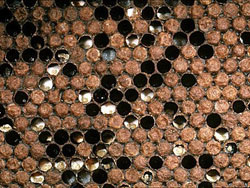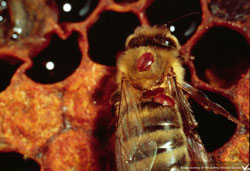Honey bees are prone to a number of pests and diseases, which can range in severity from a minor nuisance which may slightly reduce honey yield, to conditions that will rapidly kill colonies. They can usually be divided into diseases of the brood, or diseases of adult bees, but a few such as Varroa affect both. In addition, in many cases, pests and diseases may interact with each other, increasing their harmful effects.
American Foulbrood (AFB)
A disease of the sealed brood, caused by the spore forming bacterium Paenibacillus larvae. Affected larvae die and decompose to foul smelling fluid which can be drawn out as a string. They then dry out to a hard scale which remains in the cell. Cappings look sunken and greasy. The disease is very infectious, and spores can infect equipment for up to 60 years. A Statutory Notifiable Disease. If you suspect AFB, you must immediately contact your local Fera Bee Inspector.
Colonies in which AFB is confirmed will be destroyed and burnt. Fortunately the incidence of AFB in Britain is currently low.
European foulbrood (EFB)
A disease of the unsealed brood, caused by the non-spore forming bacterium Melissococcus plutonius. Secondary bacteria are usually also present. Affected larvae starve and turn a brownish colour, often appearing contorted, and often with unpleasant smell. The disease is infectious, and equipment can remain infective for several years. A Statutory Notifiable Disease. If you suspect EFB, you must immediately contact your local Fera Bee Inspector.
Colonies in which EFB is confirmed will either be destroyed and burnt, if infection is severe, or treated using an antibiotic or the "shook swarm technique". Despite Statutory control for 70 years, the incidence of EFB in Britain remains high. A very poorly understood disease, and much more research is needed.
Chalkbrood
 Chalkbrood is an infectious disease of honey bee larvae caused by a fungus called Ascosphaera apis.
Chalkbrood is an infectious disease of honey bee larvae caused by a fungus called Ascosphaera apis.
A disease of the sealed brood caused by the fungus Ascosphaera apis. Affected larvae die and dry out to a hard white or greyish “mummy”. Common in many colonies, especially in spring. Not generally considered very important, but unusually may cause the death of a significant proportion of the brood. No treatment is available in Britain, but thymol may reduce its incidence. Some strains of bee seem to be more susceptible than others.
Sacbrood
A disease of the sealed brood caused by the sacbrood virus. Affected larvae die and dry out to a black scale with a “Chinese slipper” appearance. Not very common in Britain, but certain strains of bee seem to be more susceptible than others. Little research has been carried out. No treatment is available in Britain.
Varroa
 Varroa mites on the back of a worker honey bee.
Varroa mites on the back of a worker honey bee.
Probably the most serious pest of honey bees worldwide. The parasitic mite Varroa destructor was discovered in Britain in 1993. The female mites can live on adult bees, sucking their blood, and then enter brood cells to reproduce. Mite populations can build up very rapidly. Although the mite alone appears to have little effect, it can transmit a range of normally innocuous bee viruses, which can rapidly kill colonies. These include acute bee paralysis virus, deformed wing virus, Kashmir bee virus, and slow paralysis virus. Control of Varroa is essential for colony survival. The first generation of synthetic pyrethroid chemicals are now generally ineffective, so most beekeepers use natural oils and acids such as thymol and oxalic or formic acid. Many commercial formulations are available worldwide, but there is little choice of effective treatments in Britain, so colony losses continue. Much research is being carried out into alternative treatments, and breeding for hygienic behaviour is now taking place at the University of Sussex.
Photo credit www.vita-europe.com/gallery
Nosema disease
Caused by the microsporidian fungus Nosema apis, this has long been a common infection in Britain, especially in the Spring. The parasite invades the gut and shortens the life of infected bees. It produces spores which remain infective for several years and may be spread by dysentery. In 2007, a second species Nosema ceranae was confirmed in Britain. Scientists in Spain have found this to be associated with the dramatic loss of bee colonies, but elsewhere it does not appear to be serious. More research is needed. The disease can be treated with the antibiotic fumagillin.
Tracheal mite (acarine disease)
A parasitic mite Acarapis woodi which lives in the breathing tubes of adult bees, and sucks the blood of the bee. Heavily infested bees have a shortened life and heavily infested colonies are more likely to die in the spring. Not now generally common in Britain, but may increase if a high density of colonies are kept in an area. No treatment is available in Britain.
Amoeba disease
A protozoan Malpighamoeba mellificae lives in the malpighean tubules of bees, and produces infective cysts. Believed to shorten the life of infected bees, but generally not considered very important, and little research has been carried out. Commonly found in association with Nosema. No treatment is available in Britain.
Viruses
Apart from sacbrood, and the viruses associated with Varroa mentioned above, there are a number of other viruses which occur in bees in Britain. Chronic bee paralysis virus causes crawling of infected bees, and can occasionally kill colonies, as in the “Isle of Wight Disease”. Most other viruses have no symptoms, and have been little studied, but may shorten the life of bees. Black queen cell virus and bee virus Y are associated with Nosema infections, and may increase their harmful effects. Some such as cloudy wing virus occur very commonly, but their effects and mode of transmission are unknown. Much more research is needed.
Poisoning
At various times in Britain, serious losses of honey bees have been caused by poisoning by agrochemicals, in particular insecticides applied to orchards or oilseed rape. Better education of spray operators, and safer chemicals have led to recent losses being at a very low level. If spray poisoning is suspected, contact your local Fera Bee Inspector, who will collect a sample for chemical analysis (a free service).
In recent years a new class of chemicals, the neo-nicotinoids have been blamed for colony losses, especially in France. There is no evidence that they have caused colony losses in Britain.
"Colony Collapse Disorder"
A term coined by scientists in the USA to describe a specific set of symptoms in colonies suffering unexplained sudden losses from 2006 onwards. The terms should not be used to describe all colony losses. The cause remains unknown, but the losses were almost certainly due to a combination of factors, including pests such as Varroa, diseases such as Israeli acute paralysis virus or Nosema, in combination with husbandry factors such as the long distance movement of hives, and environmental factors such as a reduction in bee forage.
"Parasitic Mite Syndrome"
A term coined by scientists in the USA in the 1990s to describe a specific set of symptoms associated with infestations of the parasitic mites Varroa and / or the tracheal mite. These symptoms are now known to be caused by viruses such as acute bee paralysis virus, deformed wing virus, and Kashmir bee virus.
"Isle of Wight Disease"
A disease of unknown origin, which devastated British beekeeping in the early 20th century. Characterised by crawling bees, unable to fly, which died suddenly in large numbers. At first thought to be caused by Nosema, and then generally agreed to be due to tracheal mites. Now considered to have been caused by a combination of multiple factors, principally chronic bee paralysis virus, together with poor weather conditions, and an excess of bee colonies being kept for the amount of forage available.
Wax moth
There are two species of wax moth found in Britain, both of which will attack wax comb and build silk lined tunnels. The lesser wax moth (Achroia grisella) is generally not a problem, but may damage the visual appearance of cut comb honey for sale or exhibition. The greater wax moth (Galleria mellonella), on the other hand, can be a serious pest, especially in warm conditions, damaging supers stored for extraction, or stored equipment. As well as destroying wax, the moth larvae will excavate cavities in woodwork. Careful hygiene and management of spare equipment is essential to avoid damage. Generally, healthy honey bee colonies can suppress, but not eliminate infestations. Can be treated with Bacillus thuringiensis.
Other pests
Fortunately bears and honey badgers, which cause destruction of beehives in other countries, do not occur in Britain. In winter, when the bees cannot protect themselves, hives can be attacked by field mice (Apodemus sylvaticus) and woodpeckers (Picus viridis), so guards are needed to prevent damage.
Exotic pests
There are two serious Statutory Notifiable Diseases which are not currently thought to occur in Britain.
The small hive beetle (Aethina tumida) is found in southern Africa where it is not considered a serious pest, but when accidentally introduced into the southern USA, it caused serious problems. It multiplies in huge numbers, eats bee brood and destroys combs. When accidentally introduced into Australia the effects have been more variable, so its impact in Britain if introduced is unclear. Two infestations in Portugal have been discovered and destroyed in recent years, so introduction in Britain is highly likely, as it may be accidentally introduced on e.g. fruit imports.
The parasitic mites Tropilaelaps clareae and Tropilaelaps koenigerum were originally pests of other Asian species of honey bee, but also affect Apis mellifera, where it is a more serious pest than Varroa. Potentially a serious pest if introduced into Britain, but as yet has not spread outside Asia.
If you suspect the presence of either of these exotic pests, you must immediately contact your local Fera Bee Inspector.


